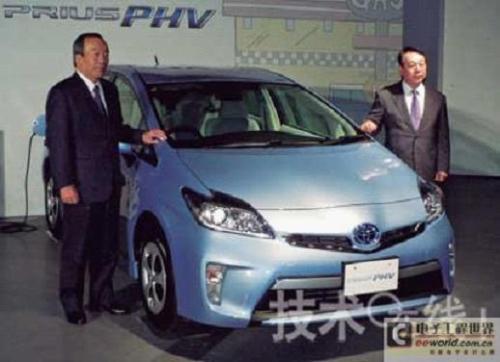 In January 2012, Toyota began listing the PHS, a plug-in hybrid electric vehicle that can be charged externally. Its feature is that compared with the Prius plug-in hybrid vehicle that is limited to sales by legal entities and administrative agencies in 2009, the distance traveled as an electric vehicle (EV) is extended.
In January 2012, Toyota began listing the PHS, a plug-in hybrid electric vehicle that can be charged externally. Its feature is that compared with the Prius plug-in hybrid vehicle that is limited to sales by legal entities and administrative agencies in 2009, the distance traveled as an electric vehicle (EV) is extended. The original model launched in 2009 was equipped with a lithium ion rechargeable battery with a capacity of 5.2 kWh. The EV travel distance was 23.4 km in the JC08 mode. While the new model reduced the capacity to 4.4kWh, it also extended the EV driving distance to 26.4km. By reducing the battery capacity, the floor surface of the trunk is reduced compared to the original. The price fell from 5.25 million yen to 3.2 million yen, and plans to sell 35,000 to 40,000 vehicles a year.
Newly developed small lithium-ion rechargeable battery modules reduce the floor surface of the trunk and ensure luggage compartment capacity. The charging port is on the right side of the rear fender, so the inside slightly protrudes.
The biggest difference between the new car and the original model is the update of the lithium-ion rechargeable battery. A new type of lithium-ion rechargeable battery with high capacity and output power is provided, which increases regenerative charging and uses tires with lower rolling resistance. When operating as a hybrid vehicle (HEV), the fuel efficiency in the JC08 mode is 31.6 km/L. The combined fuel efficiency of the plug-in hybrid drive with EV and HEV is 61.0km/L, which is higher than the original 57.0km/L.
A unit with a capacity of 20.5 Ah is used, and 14 units are used as a group, and a total of 4 groups are provided. The module weighs 80kg and has a capacity of 87L. Compared with before, the weight is reduced by 50% and the volume is reduced by 57%.
All models are equipped with the functions of displaying the charging station position, remotely operating the air conditioner, and supporting eco driving.
The original model uses a battery produced by Primearth EV Energy. Like the battery used in the three-row car of the HEV "Prius α" marketed in May 2011, the unit's current capacity is only 5 Ah. The cathode material is an NCA system using nickel (Ni), aluminum (Al), and cobalt (Co).
The new model uses a 20.5 Ah large unit manufactured by Sanyo Electric. The cathode material is based on a ternary system of Ni, Co, and manganese (Mn). Compared with the units used by HEVs, not only the capacity per unit volume can be increased, the unit size can be reduced, and the amount of charge during regeneration can also be increased.
The battery module is a set of 14 units and is equipped with 4 groups in total. The battery voltage is 207.2V. By reducing the capacity and changing the casing material from steel to aluminum alloy, the weight of the battery module was reduced to 80kg and the volume was reduced to 87L.
Charging only supports normal charging. It takes about 90 minutes to use the AC200V power supply, and it takes about 180 minutes to fully charge the AC100V power supply. It is equipped with a timer function that can be charged according to departure time and charged by night power. In addition, the new service "PHV Driving Support", which provides information such as battery remaining power and charging stations via smart phones, is standard on all models.
Customized Golf Head Cap,Golf Animal Cap Set,Popular Golf Head Cover,Knitted Animal Headcover
Grand Dragon Sports Company Limited , https://www.golfyy.com